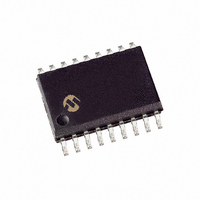MCP2515-I/SO Microchip Technology, MCP2515-I/SO Datasheet - Page 23

MCP2515-I/SO
Manufacturer Part Number
MCP2515-I/SO
Description
IC CAN CONTROLLER W/SPI 18SOIC
Manufacturer
Microchip Technology
Specifications of MCP2515-I/SO
Package / Case
18-SOIC (7.5mm Width)
Controller Type
CAN Interface
Interface
SPI
Voltage - Supply
2.7 V ~ 5.5 V
Current - Supply
10mA
Operating Temperature
-40°C ~ 85°C
Mounting Type
Surface Mount
Product
Controller Area Network (CAN)
Number Of Transceivers
1
Data Rate
1 Mbps
Supply Voltage (max)
5.5 V
Supply Voltage (min)
2.7 V
Supply Current (max)
10 mA
Maximum Operating Temperature
+ 85 C
Minimum Operating Temperature
- 40 C
Mounting Style
SMD/SMT
Supply Voltage Range
2.7V To 5.5V
Driver Case Style
SOIC
No. Of Pins
18
Operating Temperature Range
-40°C To +85°C
Filter Terminals
SMD
Supply Voltage Min
2.7V
Rohs Compliant
Yes
Clock Frequency
40MHz
Lead Free Status / RoHS Status
Lead free / RoHS Compliant
For Use With
MCP2515DM-BM - BOARD DEMO FOR MCP2515/51MCP2515DM-PTPLS - BOARD DAUGHTER PICTAIL MCP2515MCP2515DM-PCTL - BOARD DEMO FOR MCP2515DV251001 - KIT DEVELOPMENT CAN MCP2510
Lead Free Status / Rohs Status
Lead free / RoHS Compliant
Available stocks
Company
Part Number
Manufacturer
Quantity
Price
Company:
Part Number:
MCP2515-I/SO
Manufacturer:
TI
Quantity:
1 000
Part Number:
MCP2515-I/SO
Manufacturer:
MICROCHIP/微芯
Quantity:
20 000
4.0
4.1
The MCP2515 includes two full receive buffers with
multiple acceptance filters for each. There is also a
separate Message Assembly Buffer (MAB) that acts as
a third receive buffer (see
4.1.1
Of the three receive buffers, the MAB is always
committed to receiving the next message from the bus.
The MAB assembles all messages received. These
messages will be transferred to the RXBn buffers (see
Register 4-4 to Register 4-9) only if the acceptance
filter criteria is met.
4.1.2
The remaining two receive buffers, called RXB0 and
RXB1, can receive a complete message from the
protocol engine via the MAB. The MCU can access one
buffer, while the other buffer is available for message
reception, or for holding a previously received
message.
4.1.3
When a message is moved into either of the receive
buffers, the appropriate CANINTF.RXnIF bit is set. This
bit must be cleared by the MCU in order to allow a new
message to be received into the buffer. This bit
provides a positive lockout to ensure that the MCU has
finished with the message before the MCP2515
attempts to load a new message into the receive buffer.
If the CANINTE.RXnIE bit is set, an interrupt will be
generated on the INT pin to indicate that a valid
message has been received. In addition, the
associated RXnBF pin will drive low if configured as a
receive buffer full pin. See Section 4.4 “RX0BF and
RX1BF Pins” for details.
© 2010 Microchip Technology Inc.
Note:
MESSAGE RECEPTION
Receive Message Buffering
MESSAGE ASSEMBLY BUFFER
RXB0 AND RXB1
The entire content of the MAB is moved
into the receive buffer once a message is
accepted. This means, that regardless of
the
extended) and the number of data bytes
received, the entire receive buffer is
overwritten
Therefore, the contents of all registers in
the buffer must be assumed to have been
modified when any message is received.
RECEIVE FLAGS/INTERRUPTS
type
of
with the
Figure
identifier
4-2).
MAB
(standard
contents.
or
4.2
RXB0, the higher priority buffer, has one mask and two
message acceptance filters associated with it. The
received message is applied to the mask and filters for
RXB0 first.
RXB1 is the lower priority buffer, with one mask and
four acceptance filters associated with it.
In addition to the message being applied to the RB0
mask and filters first, the lower number of acceptance
filters makes the match on RXB0 more restrictive and
implies a higher priority for that buffer.
When a message is received, bits <3:0> of the
RXBnCTRL register will indicate the acceptance filter
number that enabled reception and whether the
received message is a remote transfer request.
4.2.1
Additionally, the RXB0CTRL register can be configured
such that, if RXB0 contains a valid message and
another valid message is received, an overflow error
will not occur and the new message will be moved into
RXB1, regardless of the acceptance criteria of RXB1.
4.2.2
The RXBnCTRL.RXM bits set special receive modes.
Normally, these bits are cleared to 00 to enable
reception of all valid messages as determined by the
appropriate acceptance filters. In this case, the
determination of whether or not to receive standard or
extended
RFXnSIDL.EXIDE bit in the acceptance filter register.
If the RXBnCTRL.RXM bits are set to 01 or 10, the
receiver will only accept messages with standard or
extended identifiers, respectively. If an acceptance
filter has the RFXnSIDL.EXIDE bit set such that it does
not correspond with the RXBnCTRL.RXM mode, that
acceptance filter is rendered useless. These two
modes of RXBnCTRL.RXM bits can be used in
systems where it is known that only standard or
extended messages will be on the bus.
If the RXBnCTRL.RXM bits are set to 11, the buffer will
receive all messages, regardless of the values of the
acceptance filters. Also, if a message has an error
before the EOF, that portion of the message assembled
in the MAB before the error frame will be loaded into the
buffer. This mode has some value in debugging a CAN
system and would not be used in an actual system
environment.
Receive Priority
ROLLOVER
RXM BITS
messages
is
MCP2515
determined
DS21801F-page 23
by
the
















